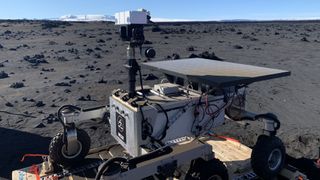Mars rover and drone prototypes brave strong Iceland winds in analog test
Robots working together will assist astronauts on rocky worlds like the moon and Mars, if Earth tests like this show it's possible.
Remember that windstorm from "The Martian"?
Mars drone and rover prototypes undergoing testing in Iceland this summer had to endure a gusty environment somewhat akin to the fictional storm in the 2016 movie.
"I've never seen such crazy winds in my life," planetary geologist Catherine Neish, an associate professor at Canada's Western University, told Space.com. "Drones cannot fly in high wind conditions, and in this case, it was so high we didn't want people out there either," Neish said, noting that the storm was near hurricane conditions.
The storm wasn't anything one would see on the Red Planet, despite the artistic license from "The Martian." But the situation showed how robots and humans alike could endure tough conditions, Neish said, and that's important preparation to get drones and rovers working together with human helpers on the moon, Mars and other rocky worlds.
Related: 12 amazing photos from the Perseverance rover's 1st year on Mars

Iceland has already emerged as an ideal spot to perform analog missions that aim to replicate the conditions, as closely as possible, that astronauts would face on deep-space missions. The island boasts a variety of habitats that resemble extraterrestrial locales, including lava flows, glaciers and mountains. Moreover, Iceland is a relatively small country, so researchers can access many types of terrain in a short excursion.
During this summer's mission, Neish's team explored a central Iceland lava flow that erupted around late 2014 or early 2015. While Mars has no active volcanism that we know of, the benefit of a fresh analog site is it has not eroded much; Martian erosion is relatively slow compared to Earth's, Neish explained.
Get the Space.com Newsletter
Breaking space news, the latest updates on rocket launches, skywatching events and more!
"We've got this fresh surface being covered over; we also see a lot of dust and sand on Mars, getting blown around and deposited on the lava flows," Neish said. "Then nearby [our site], there's actually a glacier. There's a lot of ice on Mars as well, so it really is a perfect Mars analog."
Related: Stunning new Mars photos explore the solar system's largest canyon
LiDAR scan of our #RAVEN base camp in Iceland, with our new @PhoenixLiDAR backpack system. You can see our tents, tables, solar panels, and even the rocks lining the paths! pic.twitter.com/pchFZVMwgrJuly 29, 2022
Called the Rover-Aerial Vehicle Exploration Network (RAVEN) field study, humans and robots alike explored the Holuhraun lava flow using a prototype drone built by Honeybee Robotics and equipped with a sample acquisition device. That work might be useful for NASA's aims to retrieve Martian samples with drones, like the Ingenuity helicopter from the Perseverance rover mission.
Also on site was the Mars Exploration Science Rover (MERS) from the Canadian Space Agency, and drones from the University of Arizona, as well as personnel from Canada's MDA (which operates the Canadarm robotic arms at the International Space Station) and Reykjavik University in Iceland.
During this excursion, the project's first, the team aimed to operate the rovers and drones separately with remote support from NASA's Jet Propulsion Laboratory (JPL) in California, which runs real rover missions on Mars, including Perseverance and Curiosity.
Related: Stunning Mars photos by the Curiosity rover show ancient climate shift
JPL engineers, Neish explained, would send commands over the internet. Then operations teams on site would come up with a plan based on the commands.
"JPL had certain science goals in mind, and then there would be an implementation team that would go out in the field with the rover or the drone and implement commands they were given by the operations team," Neish said.
The teams are still analyzing data about their Iceland excursions. More research papers may be coming out shortly concerning what they found. In the meantime, Neish and her collaborators are planning another visit in 2023.
At that time, the scientists hope that rovers and drones will be able to work more directly together — and under more favorable winds.
Follow Elizabeth Howell on Twitter @howellspace. Follow us on Twitter @Spacedotcom or Facebook.
Join our Space Forums to keep talking space on the latest missions, night sky and more! And if you have a news tip, correction or comment, let us know at: community@space.com.

Elizabeth Howell (she/her), Ph.D., is a staff writer in the spaceflight channel since 2022 covering diversity, education and gaming as well. She was contributing writer for Space.com for 10 years before joining full-time. Elizabeth's reporting includes multiple exclusives with the White House and Office of the Vice-President of the United States, an exclusive conversation with aspiring space tourist (and NSYNC bassist) Lance Bass, speaking several times with the International Space Station, witnessing five human spaceflight launches on two continents, flying parabolic, working inside a spacesuit, and participating in a simulated Mars mission. Her latest book, "Why Am I Taller?", is co-written with astronaut Dave Williams. Elizabeth holds a Ph.D. and M.Sc. in Space Studies from the University of North Dakota, a Bachelor of Journalism from Canada's Carleton University and a Bachelor of History from Canada's Athabasca University. Elizabeth is also a post-secondary instructor in communications and science at several institutions since 2015; her experience includes developing and teaching an astronomy course at Canada's Algonquin College (with Indigenous content as well) to more than 1,000 students since 2020. Elizabeth first got interested in space after watching the movie Apollo 13 in 1996, and still wants to be an astronaut someday. Mastodon: https://qoto.org/@howellspace

